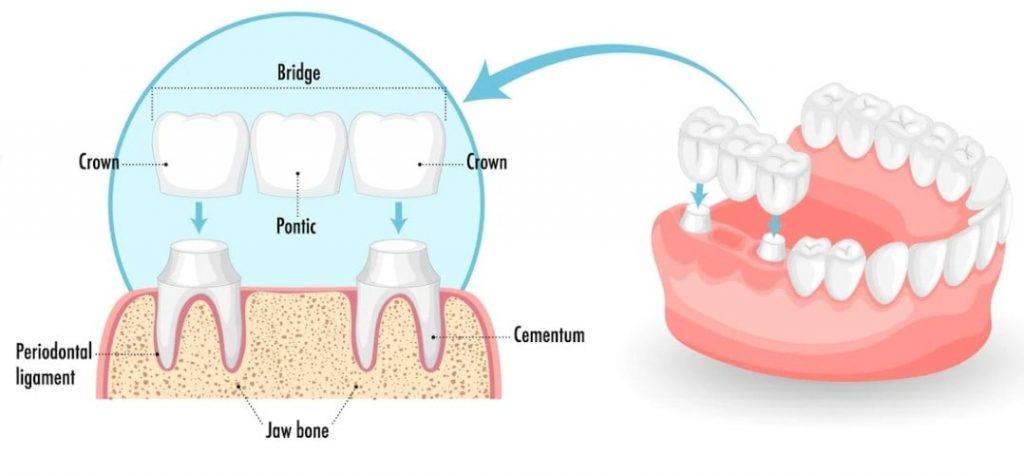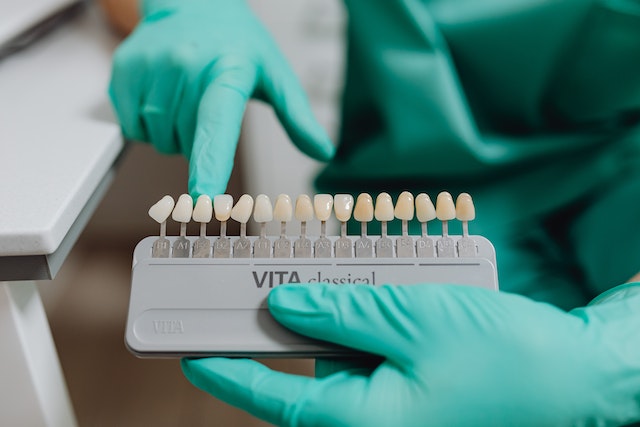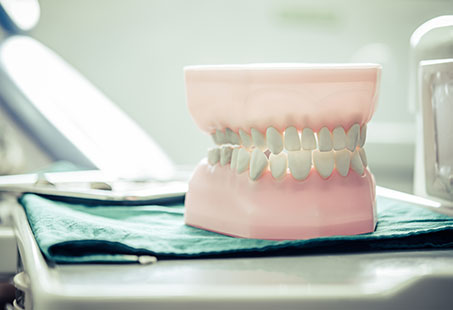Crowns and bridges are types of dental restorations that can be used both cosmetically and functionally. Many people, however, aren’t sure of the differences between the two, hence the “bridge vs crown” debate.
There are some advantages to both, of course. For instance, if you’re missing a tooth, either a crown or bridge can prevent the shifting of the surrounding teeth. And keep in mind that shifting teeth can cause misalignment and crookedness, which causes its own problems.
Still, both bridges and crowns serve different purposes, and there’s a clear distinction between them. Having this knowledge will help you know your choices when seeking dental restorations.
What’s The Difference Between A Bridge and A Crown?
The main difference between a crown and a bridge is that a crown is fitted over an existing tooth or implant, while a bridge replaces a missing tooth.
A dental crown is one artificial tooth that goes over an existing, shaved-down tooth or an implant. A dental bridge, on the other hand, is usually made up of three individual dental crowns that are connected together.

The tooth at the centre, also known as a pontic, “bridges” the missing gap between teeth. And the crowns on either side of the pontic are cemented over natural teeth or dental implants Turkey. They essentially support the bridge by keeping it in place.
Both crowns and bridges need to be cemented into place. Therefore, you cannot remove them or take them out of your mouth. Your dentist will do that when needed.
Now that we’ve got the basics down, time to get to the details.
Types
When it comes to dental crowns, “types” is taken for the different types of materials from which you can get a dental crown. So, there are gold, silver, porcelain, zirconia, metal, resin, and ceramic crowns.
They have different durabilities and colours and some types are better suited for front teeth and vice versa. With dental bridges, you get different materials (same as crowns) as well as different designs. These are:
- Traditional Bridge: It’s the most common type of bridge. It fits over natural teeth on either side of the gap left by the missing tooth. These teeth are shaved down so the crowns can fit on top. This bridge type offers the most support.
- Maryland Bonded Bridge: This bridge comes with metal or porcelain wings (instead of crowns) on both sides of the pontic. So, there’s no need to shave the adjacent teeth, as the wings are stuck to their backs. These are best suited for the most visible teeth (like the ones on the front).
- Cantilever Bridge: It is supported by just one crown on one side. Basically, it can be used when a missing tooth leaves just one natural tooth on either side. Or when one of the adjacent teeth already has another restoration.
- Implant Bridges: When the crowns on the sides of the pontic are fitted on implants instead of natural teeth, it’s an implant bridge. Two implants are needed for this.

Whether or not you’re suitable for a particular type of bridge will depend on the condition of your teeth, and the goals of the treatment. That is why make sure to consult a dental professional.
Candidates
When teeth have significant problems, both crowns and bridges can help. Rather than being purely cosmetic, they are primarily designed for functional restoration. However, the ways in which they can help are different.
With a crown you can:
- Protect the structure of a weak, decaying tooth or one that has a large filling.
- Restore the shape of teeth that are broken or cracked.
- Cover misshapen and stained teeth.
- Change the alignment of your teeth for a better bite.
- Restore the strength and appearance of a tooth.
- Support a dental bridge
- Improve your smile
However, with a dental bridge, you can:
- Replace a missing tooth that was badly broken or decayed and had to be extracted.
- Restore the strength of your teeth.
- Improve your smile.
There are certain limitations when it comes to bridges though. As mentioned above, for most bridges, your existing teeth will have to be shaved.
This isn’t something that many dentists recommend unless those teeth are not in great condition.
For instance, if your teeth aren’t strong enough due to decay or injury, a bridge can actually protect them. However, shaving down healthy teeth is avoided, if possible.
Procedure
The procedure for crowns and bridges is more or less the same.
When you arrive at the clinic, you’ll be given local anaesthesia. That way, you won’t experience any pain while you’re getting crowns or bridges.
Next, the dentist will begin preparing the teeth for crowns by shaving them down to small stubs. Following that, the impression of your teeth will be taken at the same appointment.
And this will be sent to a dental lab for preparation of the bridge or crown. Meanwhile, you’ll wear temporary teeth.
You’ll have another appointment in which you will come back to check the fitting of the restoration. The dentist will check the fit and the bite of the crown or bridge. If it has any problems, it’ll be sent back for readjustments.
Still, the second appointment is just a demo try-on. The permanent crown or bridge is fitted (using cement) in the third and last appointment.
Recovery & Aftercare
Again, the recovery from both restorations is more or less the same. The recovery will take a few days. During this time, you might experience some post-op side effects like:
- Pain
- Sensitivity
- Discomfort
- Numbness
This should, however, resolve on its own after some time. You’ll also have to be careful about avoiding hard and sticky foods.
And you also have to make sure to keep your teeth clean. For flossing with crowns, it is better to slide it out sideways than to pull it up. But with bridges, you won’t be able to floss between the teeth as the crowns are connected.
For this reason, your dentist may recommend the use of a floss threader and interdental brushes to clean underneath the bridge.
Results & Longevity
Both crowns and bridges will resemble your natural teeth, so their results are quite aesthetically pleasing. You just have to be careful about choosing the right shade.

Most crown and bridge materials don’t stain. So, these restorations will retain their original colour. If they’re too white, they may stand out from the rest of your teeth.
As far as the answer to “how long do they last” is concerned, for crowns, it’s around 10-15 years, and for bridges, it’s 5-7 years.
With bridges, you have to keep in mind that they won’t prevent the loss of the underlying jawbone. Without a tooth root in place, the jawbone won’t get enough stimulation, so it will change shape over time.
As a result, the bridge may fall off, which is why it might not last you as long as a crown with an underlying tooth or implant.
Cost
For both crowns and bridges, the cost will vary depending on:
- The material used
- Complexity of the procedure
- The number of teeth involved
- Qualification and experience of the dentist
- The location of the clinic
However, here’s a summary of the average costs of different types of dental crowns in the UK and Turkey:
| Type of Crown | UK Price | Turkey Price |
| All Porcelain | £800 | £180 |
| Porcelain Fused To Metal | £700 | £150 |
| Zirconia | £750 | £200 |
| E-max | £625 | £200 |
Dental bridges, in general, cost more than crowns because they’re made up of multiple crowns. However, depending on the type of bridge it is, the prices can further vary.
Here, you should also note that both crowns and bridges are available in NHS’ Band 3 for £282.80. However, NHS dental care is notoriously hard to get, and it’s not for cosmetic purposes. So, you may have to find a private practice.
Bridge vs Crown: Differences Summary
Here’s a summary of the differences between a bridge and a crown:
| Dental Bridge | Dental Crown | |
| Classification | Based on materials (gold, silver, porcelain, resin, ceramic, Emax, and metal) | Based on materials and design: Traditional bridge Maryland bonded bridgeCantilever bridgeImplant-supported bridge |
| Candidates | One or more missing teeth | Badly damaged/decaying teeth or to cover a dental implant |
| Procedure | All the teeth getting a crown are shaved | The teeth that will anchor the dental bridge are shaved |
| Anaesthesia | Local | Local |
| Recovery | 2-4 days | 2-4 days |
| Results | Natural-looking | Natural-looking |
| Potential complications | Infection, bridge failure, allergic reaction, tooth decay, cracks, etc. (bridge can be removed and recemented) | Chipping, allergic reaction, crown falling off, infection, increased sensitivity, etc. |
| Longevity | 5-7 years | 10-15 years |
| Average Cost | £1,200 in the UK£700 in Turkey | £650 in the UK £180 in Turkey |
Conclusion
Once you realise the differences between a bridge and a crown, it’s not that difficult to distinguish between the two. Just keep in mind that both have different treatment goals.
Bridges are for missing teeth only, while crowns need an existing tooth or implant to anchor onto. Neither are permanent, but they can last you for around a decade if you take good care of them.
In any case, make sure to discuss your needs and expectations with your dentist before deciding on any treatment. They’ll make sure to develop a suitable treatment plan for you that also meets your budget requirements.
FAQ
How many teeth can a bridge replace?
Usually, there are 3 crowns in a bridge, one in the middle and two on the sides. But if a large number of teeth are missing, long-span bridges are also available.
It could have 4 or even 12 units of crowns. However, short-span bridges are recommended as there’ll be too much pressure on the crowns otherwise.
Is it better to get a crown or a bridge?
Bridges are recommended over crowns when you’re missing a tooth entirely. Otherwise, crowns are usually used for restorations.
Is a bridge cheaper than a crown?
Dental bridges are always more expensive than crowns because they contain multiple units of crowns and may require prepping of more than one tooth.
